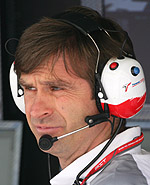 You think Interlagos and you think bumps, right?
You think Interlagos and you think bumps, right?
Pascal Vasselon - Senior General Manager Chassis: The bumps are definitely one of the foremost characteristics when you think about Sao Paulo. They have made many attempts to eliminate them but it never seems to work.
Why is that?
PV: I think it has to do with the stability of the ground and the fact that part of it used to be a lake. They have resurfaced the track many times but still you get the bumps. They are a permanent feature of the track and you tend to hear a lot about them from the drivers on the first day, but then the problem seems to go away. There are reasons. First, the drivers just get used to it. The second explanation is that the bumps are especially bad when the grip is low, so that when the grip increases bumps upset the car balance less. You have to be careful not to over-react on the first day.
Presumably you arrive with your predetermined set-up and try not to deviate?
PV: Yes. The predetermined set-up already takes into account the bumps and you try to just make fine-tuning adjustments.
What are the other key features of the track?
There is a long uphill drag out of the Juncao corner all the way past the pits and down to the first corner. That is quite demanding for engines and it obviously helps to have good power. Otherwise the circuit is nothing special in terms of the engine's contribution – an extra 10bhp will probably give you just less then 0.2s over the lap. It is not tough on brakes and you use tyres from the middle of the range. The only really outstanding point about Interlagos is in wet conditions.
In what way?
PV: It is one of very few places in the world where you can have rain with track temperatures of 25 degrees. Usually when you get rain, the weather is bad and you are below 20 degrees track temperature. So you have an operating window of the wet tyre which is usually below 20 degrees. But in Brazil and Malaysia you can have a wet track above 25 degrees, which is really demanding for the rain tyres as they are operating at a much higher temperature than is typical in Europe. It is the only place where it is really relevant to test in the hot summer weather in Europe by flooding the track. That's the problem about testing in the summer with artificial rain – we get conditions which are unrealistic at most of the tracks except Interlagos.
Would Bridgestone therefore produce a special rain tyre for Interlagos?
PV: If your main wet tyre was oriented around low temperatures, then yes, possibly. But if the previous tyre has a wide range it is still feasible to go to Interlagos and use it. We really have to make sure that the window is wide enough. They will probably have the same tyre because what we have seen in Budapest and Shanghai is that the Bridgestone tyre got better and better as the circuit dried, meaning that they are oriented more towards higher temperatures, so there should not be a need to take a special tyre.
Have you been going to Interlagos a long time?
PV: I went there for the first time in 2001 and I have special memories. It was the first year of my previous appointment with a tyre supplier, the third race of the season, and the first race that we led, when Juan Pablo Montoya made that special move on Michael Schumacher. I always look forward to Brazil.
What do you think of the atmosphere?
PV: What is quite noticeable in Brazil is the juxtaposition of two worlds. There are areas in Brazil where life is quite easy and Formula 1 fits well, but then when you see some of the poorer areas, it is quite a shocking contrast. When you compare the Churascarias with the favellas, for example! We don't get such a stark contrast at most places we go to. But while the Interlagos track itself might not have the most modern facilities in the world, it has a very special atmosphere. It is in a kind of bowl, a bit like an amphitheatre, and the crowd is passionate about motor racing and very knowledgeable. There is always a lot of noise from the grandstand right opposite the pits and you could never say that it is sterile!
How do you expect the Toyota TF106Bs to perform in Brazil?
PV: It's a circuit where we are reasonably optimistic of a strong performance, building on what we saw in Suzuka.
Is it one of those places where you get sudden swings in the weather?
PV: Yes. Usually it is hot when we go there and when it rains, you get proper rain! Then, because of the temperature it dries up very quickly and you can go from extreme weather tyres to dry tyres in very few laps. So the team has to be really on its toes and you have to take that into account when you are looking at strategy. For example, in 2004 the race started wet and then cars were changing tyres after just five laps. It can lead to unexpected results.

 You think Interlagos and you think bumps, right?
You think Interlagos and you think bumps, right?


















